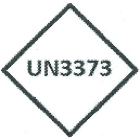Biological Products under Category B, UN3373
Acceptance
The product not falling under Table 3.6D of the current IATA DGR manual (please check with the respective cargo office for clarification on specific products) falls under Category B.
Documents required for transportation of Biological Substance, Category B
The following documents are in addition to the documents required to book General CarGo:
- Letter from the laboratory pertaining to compliance of packing instruction PI 650 as per IATA DGR.
- Description of the content.
- 24 hours emergency contact number.
Packing, marking and labelling
The packaging must be of good quality, strong enough to withstand the shocks and loadings which are usually encountered during transport (like by vibration, or by changes in temperature, humidity or pressure). The packaging must meet the following specifications:
- The primary receptacle must be leak-proof and must not contain more than 1L/1kg of content.
- The outer packaging must be waterproof and leak-proof.
Primary receptacle should be free from any marks of tempering.- Absorbent material must be placed between the primary receptacle and the outer packaging. The absorbent material must be in sufficient quantity in order to absorb the entire content of the primary receptacle(s) so that any release of liquid substance will not compromise the integrity of the cushioning material or of the outer packaging.
- The outer packaging must not contain more than 4L/4kg of content excluding gel packs.
- At least one surface of the outer packaging must have a minimum dimension of 10cmX10cm.
- For transportation, a ‘diamond- shaped mark specifying UN3373’ must be displayed on the external surface of the outer packaging on a background of a contrasting colour and must be clearly visible and legible.
- Proper shipping name ‘Biological Substance, Category B’ must be marked on the outer packaging adjacent to the diamond-shaped mark.
Label to be embossed on packages

Exceptions
These
- Substances which do not contain infectious substances or substances which are unlikely to cause disease in humans or animals are not subject to these regulations unless they meet the criteria for inclusion in another class.
- Substances containing micro-organisms, which are non-pathogenic to humans or animals are not subject to these regulations unless they meet the criteria for inclusion in another class.
- Substances in a form that any present pathogens have been neutralised or inactivated such that they no longer pose a health risk are not subject to these regulations unless they meet the criteria for inclusion in another class.
- Environmental samples (including food and water samples), which are not considered to pose a significant risk of infection are not subject to these regulations unless they meet the criteria for inclusion in another class.
- Dried blood spots, collected by applying a drop of blood onto absorbent material are not subject to these regulations.
- Fecal occult blood screening samples are not subject to these regulations.
- Blood or blood components which have been collected for the purpose of transfusion or for the preparation of blood products to be used for transfusion or transplantation and any tissues or organs intended for use in transplantation, as well as samples drawn in connection with such purposes, are not subject to these regulations.
- Patient specimens for which there is minimal likelihood that pathogens are present are not subject to other provisions of these regulations provided.
- The specimen must be packed in a packaging which will prevent any leakage and which is marked with the words ’Exempt human specimen‘ or ’Exempt animal specimen’, as appropriate;
- The packaging must consist of three components:
- A leak-proof primary receptacle(s)
- A leak-proof secondary packaging; and
- The outer packaging of adequate strength for its capacity, mass and intended use and with at least one surface having minimum dimensions of 100 mm × 100 mm;
- For liquids, absorbent material in sufficient quantity to absorb the entire contents must be placed between the primary receptacle(s) and the secondary packaging so that, during transport, any release or leak of a liquid substance will not reach the outer packaging and will not compromise the integrity of the cushioning material;
- When multiple - primary fragile receptacles are placed in a single secondary packaging, they must be either individually wrapped or separated to prevent contact with each other.


